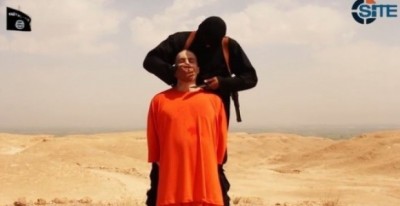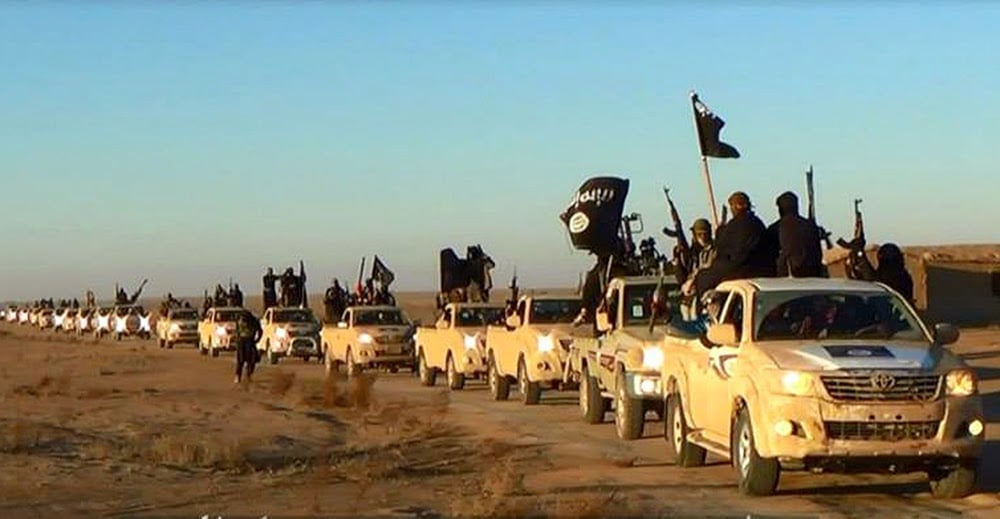The Islamic State: Who Is ISIS? An Open Source Investigation

The hysteria over the supposed threat posed by the Islamic State (IS) is now undeniable. Every day new stories emerge focusing on the group’s brutality, its resources, its capabilities and its intention to strike out at the West. The US Defense Secretary, Secretary of State, Chairman of the Joint Chiefs of Staff and ranking Senators have all delivered somber assessments of the group’s evil aims in recent weeks, and have they been joined in that effort by a host of counterparts in foreign nations.
The mainstream media, for their part, report these pronouncements without question, and with only a bare minimum of context to help their audience understand the group.
An open source investigation is desperately needed to sort through the hype to determine the facts behind this shadowy terror group. In this article we will examine the background, current status and future aims of the group, as well as the numerous facts that have been carefully omitted from the officially-sanctioned narrative of the group.
[Not a Corbett Report member? Sign up today.]
Background – History of ISIS
The Islamic State is a caliphate established by a jihadist Islamic group in June 2014. Their expressed goal is to establish Salafist government over the Levant region of Syria, Lebanon, Israel, Jordan, Cyprus and Southern Turkey. The group’s leader, Abu Bakr al-Baghdadi, has been declared caliph and “leader for Muslims everywhere.”
The Islamic State has gone through numerous name changes since its founding in Iraq in 1999. originally known as Jamāʻat al-Tawḥīd wa-al-Jihād (JTJ), (“The Organization of Monotheism and Jihad”), it changed to Tanẓīm Qāʻidat al-Jihād fī Bilād al-Rāfidayn (“The Organization of Jihad’s Base in the Country of the Two Rivers”) in 2004 after the group swore allegiance to Osama Bin Laden. During this period it was popularly known as Al Qaeda in Iraq (AQI). In 2006 it became the Islamic State of Iraq (ISI), but changed again in 2013 after expanding into Syria. At that point it became Islamic State of Iraq and the Levant (ISIL) or Islamic State of Iraq and al-Sham (ISIS). Its latest moniker, the “Islamic State,” came about after the proclamation of a new caliphate on June 29, 2014.
 The group was founded by Abu Musab al-Zarqawi in 1999. Zarqawi, a Sunni militant from Jordan, enjoyed a remarkable career that involved numerous imprisonments, escapes, evacuations, deaths and resurrections. Meeting Osama Bin Laden in Afghanistan at the tail end of the Soviet-Afghan war, Zarqawi was imprisoned in Jordan for six years for attempting to overthrow the Jordanian government. Released in 1999, he made his way to Afghanistan where he ran a militant training camp before making his way to Iraq, allegedly via Iran. During his time in Iraq, he was killed in a bombing raid in April of 2003; miraculously resurrected to be arrested in Fallujah in 2004; re-arrested in Baakuba in January of 2005; evacuated from Iraq in May of 2005; killed in fighting in June of 2005; and once again resurrected to be killed once again (presumably for good) in 2006.
The group was founded by Abu Musab al-Zarqawi in 1999. Zarqawi, a Sunni militant from Jordan, enjoyed a remarkable career that involved numerous imprisonments, escapes, evacuations, deaths and resurrections. Meeting Osama Bin Laden in Afghanistan at the tail end of the Soviet-Afghan war, Zarqawi was imprisoned in Jordan for six years for attempting to overthrow the Jordanian government. Released in 1999, he made his way to Afghanistan where he ran a militant training camp before making his way to Iraq, allegedly via Iran. During his time in Iraq, he was killed in a bombing raid in April of 2003; miraculously resurrected to be arrested in Fallujah in 2004; re-arrested in Baakuba in January of 2005; evacuated from Iraq in May of 2005; killed in fighting in June of 2005; and once again resurrected to be killed once again (presumably for good) in 2006.
The group was taken over by Abu Omar al-Badhdadi (Hamid Dawud Mohamed Khalil al Zawi, also known as Abu Abdullah al-Rashid al-Baghdadi and Abu Hamza al-Baghdadi). Baghdadi, exactly like Zarqawi before him, enjoyed an interesting career of imprisonments, deaths and resurrections, as well as questions as to his very existence. He was reported as captured on March 9, 2007, but that claim was retracted on March 10. In May 2007 the Iraqi Interior Ministry reported he had been killed, but the very next month the US military proclaimed he had never existed, citing information from a detainee who said that recordings of Baghdadi were actually recordings of an Iraqi actor hired to put a local face to what was in fact a foreign-run terror campaign, a claim subsequently echoed by Hamas-Iraq. However Baghdadi was reported as arrested on April 23, 2009, a claim that was denied by ISI the next month. The group continued to release recordings of Baghdadi throughout 2009 and 2010 that were authenticated by the (highly suspect) SITE Institute. He was reported as killed once again in April 2010 after a rocket attack on the home he was hiding.
The group was then taken over by Ibrahim ibn Awwad ibn Ibrahim ibn Ali ibn Muhammad al-Badri al-Samarrai, better known by his nom de guerre, Abu Bakr al-Baghdadi. This Baghdadi, too, has an uncertain background constructed from conflicting reports. Alleged to have been born in Samarra, Iraq, in 1971, an unverifiable internet biography claims he attained a PhD in Islamic studies at the Islamic University of Baghdad, and unidentified reports suggest he may have been a cleric at a mosque in Samarra during the American invasion in 2003. He was then captured and held as a civilian detainee by US Forces-Iraq at Camp Bucca before being granted an unconditional release on a recommendation from the Combined Review and Release Board. The Defense Department officially proclaims he was detained from February to December 2004, but Army Col. Kenneth King, the former commander of Camp Bucca, insists he was at the camp until 2009, when he was turned over to the Iraqi justice system after the camp’s closure. He was announced as leader of the ISI in May 2010 and reported captured in December 2012, a claim that was immediately denied. He oversaw the expansion of the group into Syria in 2013 and was rumoured to have been killed in June 2014, but a rare video of him delivering a sermon at a mosque in Mosul appeared less than 24 hours later to quash the rumor. He was proclaimed Caliph Ibrahim and leader of all Muslims upon the establishment of the Islamic State caliphate on June 29, 2014.
 The New Face of the War on Terror
The New Face of the War on Terror
The group sprang to the attention of those in the West this year when the group launched an incursion into Iraq that saw them repel the Iraqi army and capture Mosul, Iraq’s second largest city, as well as parts of Salahuddin and Ninevheh Provinces, and the cities of Fallujah and Tikrit. According to reports, the group seized as much as $429 million dollars from Mosul’s central bank after taking over the city. With anywhere from 4,000 to 80,000 fighters, the group possesses convoys of identical Toyota trucks, and an arsenal most countries in the region would be envious of, including Stinger missiles, anti-aircraft guns, anti-tank weapons, Blackhawk helicopters and cargo planes, and even a Scud missile. The group also allegedly gained possession of nuclear materials from Mosul University, but the IAEA believes the material is not of sufficient quality to be dangerous in nuclear terrorism.
A stream of increasingly hysterical reports about the group and its supposed existential threat to the region and the world in general has included a joint press conference by US Secretary of Defense Hagel and Joint Chiefs of Staff Chair General Dempsey in which they laid out ISIS’ “End-of-Days” vision and stressed that the group is “beyond anything that we’ve seen.” Senator James Inhofe has joined the fray, insisting that the group is working on plans to “blow up” an American city, and numerous outlets have now suggested that city may be Chicago. The hysteria increased with the release of the (now admittedly fake) beheading video of American journalist James Foley and the similarly suspicious video of American-Israeli journalist Steven Sotloff.
In August, President Obama ordered airstrikes over northern Iraq to combat the ISIS threat, warning Americans that the bombing would be a “long-term project.” The airstrikes have been endorsed by Pope Francis, and after Secretary of State Kerry announced that a “worldwide coalition” would be required to defeat the Islamic State, the US has since declared the formation of just such a “core coalition” which includes NATO powers such as the UK.
Alternative Accounts
The group and its leaders have been shrouded in myth and mystery since its inception, as documented above. Even the US government has declared that the Islamic State’s second leader, Abu Omar al-Baghdadi, never existed. The current leader, Abu-Bakr al-Baghdadi, is so elusive that there are only two known photographs and one video recording of him in existence, leading security “experts” to declare: “They know physically who this guy is, but his backstory is just myth.” This has led many to speculate on the group’s possible founding and backing by Western intelligence as a front for foreign policy goals such as the sectarian division of Iraq or as an excuse to keep the west militarily involved in the region. As far back as 2006 the UK Telegraph reported that prominent Sunni insurgent leaders in Iraq were claiming that the group’s founder, Abu Musab al-Zarqawi, was “”an American, Israeli and Iranian agent who is trying to keep our country unstable so that the Sunnis will keep facing occupation.” This sentiment is echoed to the present day, with Saudi scholar Consultative Assembly member Dr. Aissa Al-Ghaith claiming that the Islamic State is backed by America, Israel and Iran. This sentiment is bolstered by the revelation earlier this year that ISIS fighters were trained by the US military at a camp in Jordan in 2012.
There are many questions surrounding the group’s online PR activities and its unlikely facility with various forms of media, a phenomenon that even the New York Times has noted. Although much has been made of the rounds of photos claiming to show the group’s brutal execution and treatment of its prisoners, at least some of these photos appear to have been recycled from other countries at other times. There is still no answer as to who staged the beheading video of James Foley or why it was faked, but many point to the fact that British authorities warned that merely looking at the video might qualify as terrorism as a sign of the video’s true nature and origins.
 This continues a tradition of suspicious ISIS media releases dating back to the recordings of Abu Omar al-Baghdadi that were released during the 2009-2010 period after the US government had declared him a fictitious character and Iraqi authorities reported that he was under arrest.
This continues a tradition of suspicious ISIS media releases dating back to the recordings of Abu Omar al-Baghdadi that were released during the 2009-2010 period after the US government had declared him a fictitious character and Iraqi authorities reported that he was under arrest.
An image of US Senator John McCain in Syria in April 2013 has generated controversy for claims that it pictures him with ISIS member Mohammad Nour and even ISIS leader Baghdadi himself. Some have cast doubt on whether the man in the photograph is Baghdadi, but the man does bear an uncanny resemblance to the official picture of Baghdadi on the State Department “Rewards for Justice” website.


